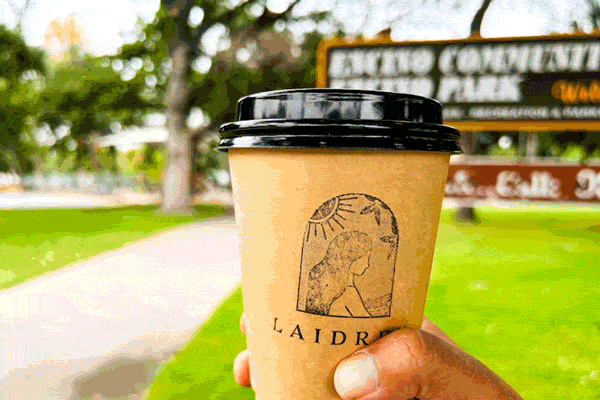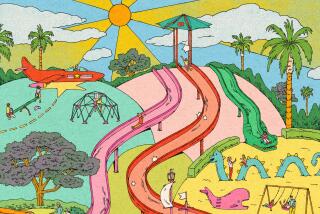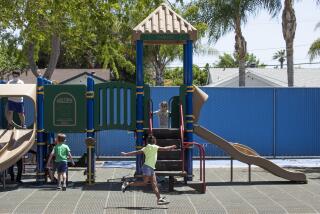Playgrounds Need to Let the Good Times Roll
- Share via
From the lobbies of fast-food restaurants to the backyards of day-care centers, the last decade has witnessed a national boom in playground construction.
But how good are these modern playgrounds? Experts fear the answer is not very, and they are concerned that the value of play in a public park or playground is being badly undervalued by parents.
“It’s an awful situation,” said Philip C. Myrick, manager of the Project for Public Spaces, a New York-based nonprofit organization that studies urban parks. “And most people aren’t even aware of the possibilities that exist.”
Myrick and others complain that playgrounds have become unimaginative and boring. They believe there are too few playgrounds generally and far too few good ones, particularly in the nation’s urban centers.
Fears about safety, liability and rising costs caused many jurisdictions to close playgrounds in the ‘80s and ‘90s. And even the municipalities that have replaced old playgrounds have sometimes been too zealous in their pursuit of safety, critics say.
“Kids aren’t being challenged by new playgrounds because the challenge has been taken out,” said Kevin Owens, chief designer for Playworld Systems, a Lewisburg, Pa., play equipment manufacturer. “There are a lot of things battling against making playgrounds fun.”
Playground safety standards are set by the federal Consumer Product Safety Commission and the American Society for Testing and Materials. While those national standards are voluntary (although a handful of states mandate them, including California and Texas), most manufacturers adhere to them closely.
No one objects to safer playgrounds, of course, but when manufacturers merely make swings shorter, slides less steep and elevations lower, children react by using a playground improperly--say, jumping off a 10-foot roof rather than a 2-foot platform.
“We could do a much better job in design,” said Susan D. Hudson of the National Program for Playground Safety, a University of Northern Iowa-based nonprofit that serves as a national clearinghouse for playground safety information. “Certainly you can design a safe playground that doesn’t have high play value. That happens.”
The rise of organized sports has put playgrounds at a disadvantage, too. Parents are more inclined to lobby local government for ball fields than playgrounds, and it can strain recreation department budgets to accommodate both.
*
Meanwhile, suburban families are buying more expensive backyard play equipment. “The middle class feel safer and more secure having their children in their own backyard,” said Darrell Hammond, founder of KaBoom, a Washington-based agency that promotes playground development. “Unfortunately, kids like to be in masses. They don’t choose to be isolationist.”
Five years ago, Hammond founded KaBoom to try to bring together people, community organizations and businesses to develop playgrounds. Today, the nonprofit organization has a Web site (https://www.kaboom.org) and offers tips and strategies to communities that want to build new playgrounds.
“Parents are so fed up with having no place for their children to play, they’re banding together to raise money and volunteer their time,” he said.
That’s exactly what Nancy Castaldo did. The Harford County, Md., mother of two and test manager at Aberdeen Proving Ground was unimpressed with the local playgrounds when her children reached preschool age.
“They’d play for 15 or 20 minutes and get bored,” she said. “There didn’t seem to be enough to do.”
With the help of about 100 families, she raised more than $100,000 to build the sprawling Rockfield Creative Playground, an outdoor amusement park made of wood and sweat equity.
Since its completion two years ago, the playground has been spectacularly successful--on a warm Saturday or Sunday afternoon, rarely are spaces available in a playground parking lot that holds 165 cars.
Playground advocates admit that more playgrounds will be built only if people are willing to put their time and money behind them. But before that can happen, they argue, people need to understand the value of playgrounds.
Dr. Robin G. Chernoff, a pediatrician and director of the children’s behavioral clinic at Johns Hopkins Children’s Center, says playgrounds provide more for children than just exercise. They also give youngsters a chance to learn how to socialize, to overcome their fears and to take pride in new skills.
“A good playground can give a child a sense of confidence and competence,” said Chernoff, who finds them most critical for children 5 and younger. “Play is how children develop. It’s their work in life.”
A better public playground needn’t be huge, the critics contend. It would, however, feature creative ways to play that aren’t necessarily more dangerous but are certainly more inspiring than much of what’s being offered to children now.
Instead of a traditional slide, for instance, a playground might have a double slide to accommodate multiple users. A talk tube (a pipe through which children can converse) can encourage imaginative games. A balance beam doesn’t have to be 4 feet off the ground, but it can challenge users if it zigs and zags.
“If we demanded that our public playgrounds be kept up as well as our public golf courses, we’d be in good shape,” Hudson said. “For some reason, child’s play isn’t important to us, and that has to change.”
(BEGIN TEXT OF INFOBOX / INFOGRAPHIC)
Public Playground Safety Checklist
1. Make sure surfaces around playground equipment are covered with at least 12 inches of wood chips, mulch, sand or pea gravel or with mats made of safety-tested rubber or rubber-like materials.
2. Check that protective surfacing extends at least 6 feet in all directions from play equipment. For swings, be sure surfacing extends twice the height of the suspending bar in front and in back.
3. Make sure play structures more than 30 inches high are spaced at least 9 inches apart.
4. Check for dangerous hardware, like open “S” hooks or protruding bolt ends.
5. Make sure spaces that could trap children, such as openings in guardrails or between ladder rungs, measure less than 3 1/2 inches or more than 9 inches.
6. Check for sharp points or edges in equipment.
7. Look out for tripping hazards, like exposed concrete footings, tree stumps and rocks.
8. Make sure elevated surfaces, like platforms and ramps, have guardrails.
9. Check playgrounds regularly to see that equipment and surfacing are in good condition.
10. Carefully supervise children on playgrounds.
Sources: U.S. Consumer Product Safety Commission and Ka-Boom, a national nonprofit organization.
More to Read
Sign up for Essential California
The most important California stories and recommendations in your inbox every morning.
You may occasionally receive promotional content from the Los Angeles Times.












